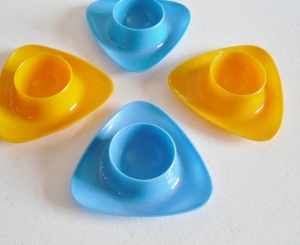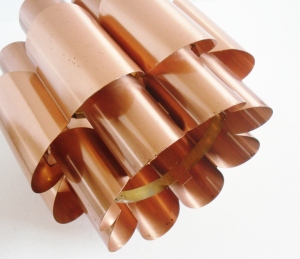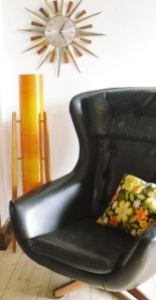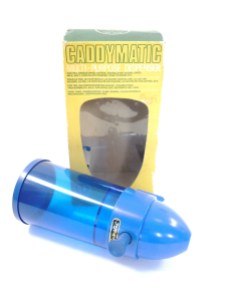Here is our latest article for Vintage Lige magazine..all about how the space race in the late 50s and 60s influenced the design of our homes.
One small step for man, one giant leap for our homes!
Space exploration during the 1960s was not just about NASA officials and the competition to see who would successfully reach the moon first. It influenced everyone on the ground too, even impacting the design choice in our homes.
The Space Age began in 1957 when the Soviet Union launched Sputnik 1, followed with the first man in space in 1961. One of the defining moments in modern history happened in 1969, when Neil Armstrong stepped onto the moon. This decade started and ended with a fascination of the unknown and a great belief in the future. Television didn’t escape the excitement either with programmes such as the Jetsons characterising life in 2062, with high tech gadgets and a space influenced home. Before this, the focus was on the past, now we were aiming to the future….far into the 21st century.
Every part of the house was affected. Lighting, ceramics, furniture, fabric, clocks and even toys took on space age shapes made from newly developed plastics.
Beam me up…
 The biggest impact was on lighting. At a time when the Victorian reproduction look was booming, spaceship like shades emerged with interwoven pieces made from gently folded plastic or metal. Furniture designers of the time also got on board with Guzzini’s pull down mushroom light and Panton’s astronaut helmet inspired lamp. For budgets that couldn’t stretch to these, the choice was a simple paper moon shade.
The biggest impact was on lighting. At a time when the Victorian reproduction look was booming, spaceship like shades emerged with interwoven pieces made from gently folded plastic or metal. Furniture designers of the time also got on board with Guzzini’s pull down mushroom light and Panton’s astronaut helmet inspired lamp. For budgets that couldn’t stretch to these, the choice was a simple paper moon shade.
The defining lights of this era were both rocket shaped. The lava lamp was designed in 1963 but didn’t become popular until later in the decade. The hippy generation loved its psychedelic feel, but with its torpedo shape and flowing lava inside, it is reminiscent of outer space.
The rocket lamp made from spun resin was a must have in the 1960s. Standing on 3 teak legs, the orange rocket is tall and eye catching….and lit up sends a warm glow around the room.
Furnishing your pod!
Furniture also embraced this love affair with all things space related. Many people rejected the country cottage pine trend, instead choosing new radical shapes and materials. Chairs became pod like with popular styles such as the Arne Jacobsen Egg Chair, with its winged back and metal swivel base. Even wicker joined in with the ceiling hung pod. The Arkana table captured the mood perfectly with the free flowing lines of its tulip base. With the addition of a glossed white finish it looked futuristic and sleek. 
The ultimate space design was Panton’s inflatable chair, designed as early as 1960. However, it was his S chairs that literally defied gravity. This one piece of free flowing plastic took an amazing 10 years to produce with the end result being stackable, brightly coloured and still influences furniture design today.
Complementing the look
Clocks became a feature in the 1960s, desired for their style rather than just function. Metamec’s starburst clock was seen as modern with its glossy moon like face and teak spikes. Candle holders were often on 3 legs with the candle forming the rocket.
 The 1960s kitchen got involved too, using the newly fashionable and durable melamine. Egg cups in flying saucer shapes brightened up the home as well as camping trips. The ultimate in space age influenced design is the Caddy-matic: a rocket shaped tea dispenser. Designed by Arthur Douglas, they were wall hung, sprung loaded and always in bright colours.
The 1960s kitchen got involved too, using the newly fashionable and durable melamine. Egg cups in flying saucer shapes brightened up the home as well as camping trips. The ultimate in space age influenced design is the Caddy-matic: a rocket shaped tea dispenser. Designed by Arthur Douglas, they were wall hung, sprung loaded and always in bright colours.
The science behind it all
While the 1960s look was rocket shaped, the 1950s was influenced by the planetary world. At the Festival of Britain, great displays of molecular structures explaining our universe were shown to millions in the newly built Dome of Discovery. The focus here was on the science behind what would be achieved in the next decade.
New designs for the home had brightly coloured ball feet, hooks for the wall resembled the science seen in the dome, magazine racks, coat stands and planters all joined in creating a modern look to complement silver metal legged chairs and kidney shaped tables. Still seen today, they are a great way to add a 1950s look to your home.
Both Lucienne Day and David Whitehead designed textiles for the festival.. New bark cloth designs emerged covered in stylised planet forms, always with Saturn’s rings, which were joined by bright swirls and spindly drawn connectors. Even the plant designs such as Day’s Calyx is reminiscent of the atomic world with rocket shaped flower heads again with the fine lines connecting each plant.
Nothing since has impacted home wares on such a scale as this, except maybe world travel. Ironically, interior design recently has been influenced by the past, replicating this space age look…the look that actually focused on the future. Modern retailers now sell almost exactly the same pieces…but the originals are still out there to be found. The way we are going our homes will actually look like the Jetson’s, in 2062!


1 Comment